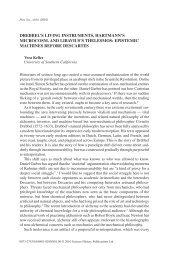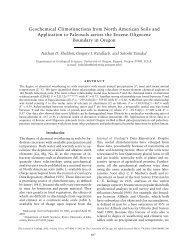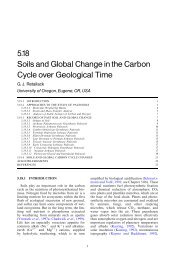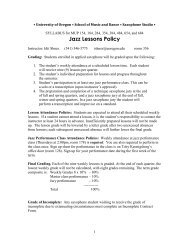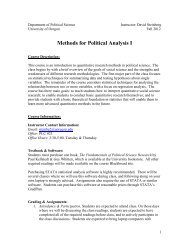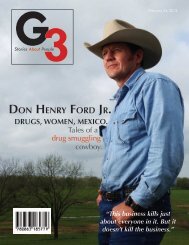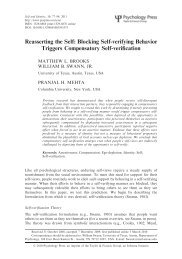Retallack 2007 Proserpina principle - University of Oregon
Retallack 2007 Proserpina principle - University of Oregon
Retallack 2007 Proserpina principle - University of Oregon
Create successful ePaper yourself
Turn your PDF publications into a flip-book with our unique Google optimized e-Paper software.
References 2310 610 510 410 3Archaean cyanobacteriaArchaean actinobacteriaArchaean actinolichens?Archaean methanogensPaleoproterozoic paleosol problematicaNeoproterozoic ascomycetes?Neoproterozoic lichens?Ordovician millipedesOrdovician mossesDevonian chytrid fungiDevonian trees and swampsTriassic sauropods and termitesCretaceous angiospermsCretaceous ornithopodsOligocene grasslandsGlacial terminationsEutrophic forest, swamp, grasslandOligotrophic forest, bog, desertHolocene eutrophic ecosystemsAutumn leaf fallSpring buddingAtmospheric CO 2 (ppmV)10 2 10 9 10 8 10 7 10 6 10 5 10 4 10 3 10 2 10 1AltithermalLittle ice ageGlobal warmingMillions Centuries DecadesYears before presentFigure 16 The <strong>Proserpina</strong> <strong>principle</strong> relates variation in atmospheric CO 2 concentration with coeval evolutionaryand ecological events on a variety <strong>of</strong> timescales. Carbon sequestering evolutionary innovations andecological transitions (closed symbols) alternate with carbon oxidizing evolutionary innovations andecological transitions (open symbols). The CO 2 curve is a composite <strong>of</strong> those shown in Figure 2 and byKasting (1992).affect life and the carbon cycle, producing transientgreenhouse events (<strong>Retallack</strong>, 2001b).Ocean currents and mountain building alsoare likely to play a role in carbon sequestration(Raymo and Ruddiman, 1992; Ramstein et al.,1997). Soils and their ecosystems play an importantrole in the carbon cycle today, and thehistory <strong>of</strong> that role now decipherable frompaleosols appears ripe for modeling and otherquantitative comparisons with other likely controlson global paleoclimate change.ACKNOWLEDGMENTSNathan Sheldon, Hope Jahren, and TimWhite have been sounding boards for the ideaspresented here. I also thank J. I. Drever andH. D. Holland for helpful reviews.REFERENCESAlgeo T. J. and Scheckler S. E. (1998) Terrestrial–marine teleconnectionsin the Devonian: links between the evolution <strong>of</strong>land plants, weathering processes and anoxic events. Phil.Trans. Roy. Soc. London B 353, 113–130.Allen J. R. L. (1974) Geomorphology <strong>of</strong> Siluro-Devonianalluvial plains. Nature 249, 644–645.Amundson R., Stern L., Baisden T., and Wang Y. (1998)The isotopic composition <strong>of</strong> soil and respired CO 2 .Geoderma 82, 83–114.Bakker R. T. (1985) The Dinosaur Heresies. WilliamMorrow, New York.Barley M. E., Pickard A. L., and Sylvester P. J. (1997)Emplacement <strong>of</strong> a large igneous province as a possiblecause <strong>of</strong> banded iron formation 2.45 billion years ago.Nature 385, 55–58.Barsukov V. L., Volkhov V. P., and Khodakovsky I. L.(1982) The crust <strong>of</strong> Venus: theoretical models <strong>of</strong> chemicaland mineral composition. J. Geophys. Res. Suppl. 87A,3–9.Basilevsky A. T., Kuzmin R. O., Nikolaeva O. V., ProninA. A., Ronca A. B., Avdvesky V. S., Uspensky G. R.,Cheremukhina Z. P., Semenchenko V. V., and LadyginV. M. (1985) The surface <strong>of</strong> Venus as revealed bythe Venera landings. Part II. Geol. Soc. Am. Bull. 96,137–144.Bell J. F. (1996) Iron sulfate, carbonate and hydrated mineralson Mars. In Mineral Spectroscopy: A Tribute toRoger G. Burns (eds. M. D. Dyar, C. MacCammon, andM. W. Schaeffer). Geochem. Soc. Spec. Publ., vol. 5,pp. 359–380.Berner R. A. (1997) The rise <strong>of</strong> plants and their effect onweathering and atmospheric CO 2 . Science 276, 543–546.Berner R. A. and Kothavala Z. (2001) GEOCARBIII: arevised model <strong>of</strong> atmospheric CO 2 over Phanerozoictime. Am. J. Sci. 301, 182–204.Berner R. A., Petsch S. T., Lake J. A., Beerling D. J., PoppB. N., Lane R. S., Laws E. A., Westley M. B., Cassor N.,Woodward F. I., and Quick W. P. (2000) Isotopic fractionationand atmospheric oxygen: implications forPhanerozoic evolution. Science 287, 1630–1633.Bestland E. A. (2000) Weathering flux and CO 2 consumptiondetermined from paleosol sequences across theEocene–Oligocene transition. Palaeogeogr. Palaeoclimatol.Palaeoecol. 156, 301–326.Bestland E. A. and <strong>Retallack</strong> G. J. (1993) Volcanicallyinfluenced calcareous paleosols from the MioceneKiahera Formation, Rusinga Island, Kenya. Geol. Soc.London J. 150, 293–310.



